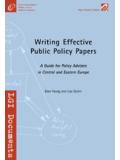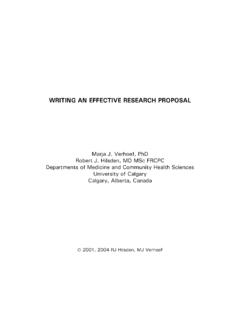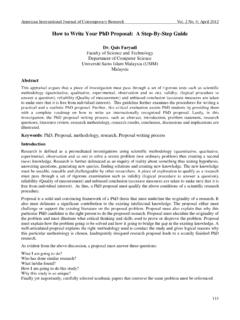Transcription of The Policy Research Proposal - Descriptor
1 1 The Policy Research Proposal - Descriptor1 Overview The Policy Research Proposal is a document that details the rationale for and a proposed approach to the investigation of a specific Policy problem. It is commonly produced in response to an open or targeted call for proposals. In submitting a Policy Research Proposal you are usually in competition with other applicants to receive project funding, a fellowship or post-graduate study opportunity. Therefore, the purpose of a Research Proposal is to convince the target audience that your Research is the most suitable to receive the intended funding, support or approval. Although specific evaluation criteria vary from audience to audience, this is generally achieved by presenting a Proposal which has the following characteristics: Policy relevant - a piece of Research which is timely and will directly contribute to solving the identified problem within it's current context; situated - clearly presented within the framework of the literature, previous Research , and past policies proposed and adopted to solve the identified problem; practical - presents a clearly testable Research design that is outcome-oriented, it will produce results which will substantively inform the Policy choices within the target context; integrated - all elements of the outlined Research plan build on each other to present an extensively developed, coherent and detailed approach.
2 The Policy Research Proposal has much in common with many aspects of a standard grant Proposal and therefore, the promotional aspects of the writing ( stressing what's new, unique, different or innovative in all areas) is also key to a successful Research Proposal . It is particularly important in this regard to make as many connections as possible to the identified priorities of the organisation to which you are making your application. Common elements of a Policy Research Proposal Most calls for application will give specific guidelines for what should be included in your Research Proposal , as well as the expected length and format. Below is an overview of the elements of a Policy Research Proposal most commonly requested. However, always remember if you're preparing a Policy Research Proposal for submission to a specific organisation, always locate and/or request their guidelines and follow them.
3 1 This Descriptor was developed by International Centre for Policy Advocacy and draws on the following sources: Connor, Ulla and Anna Mauranen (1999) 'Linguistic Analysis of Grant Proposals: European Union Research Grants'. English for Specific Purposes 18:1, 47-62. Eliason, Leslie. Guidelines for Research Design Project. Available on the World Wide Web. URL: ~leliason/assets/502 (1 Feb. 2004). Robson, Colin (2002) Real World Research : A Resource for Social Scientists and Practitioner-Researchers. 2nd Edition. Oxford: Blackwell Publishers. Marshall, Catherine and Gretchen B. Rossman (1989) Designing Qualitative Research . Thousand Oaks, CA: Sage Publications. Majchrzak, Ann (1984) Methods for Policy Research . Thousand Oaks, California: Sage Publications. Yin, Robert K (2009) Case Study Research : Design and Methods. 4th Edition. Thousand Oaks, CA: Sage Publications. 2 The common elements of a Policy Research Proposal are: Introduction/Abstract Rationale for the Research Goal/Objectives of the Research Research Methods Expected Results/ Policy Relevance Institution and personnel Timeline and Budget Bibliography More specifically: 1.
4 Introduction/Abstract The introduction/abstract aims to introduce and briefly summarise the Research project and generate the initial interest of the audience. The introduction/abstract commonly includes the following features: title of the project; a one paragraph summary of the Proposal (covering the significant aspects of the problem addressed, the hypothesis to be tested, the cases used and the expected results). 2. Rationale for the Research This element of the Proposal aims to establish the need for the proposed Research . This is generally achieved through the presentation an argument, supported by multiple sources2, which details the type of insight that needs to be developed for the target problem within the current Policy environment and therefore, provides a solid justification for the chosen Research questions. The rationale element usually includes the following features: A clear statement of the Policy problem; A short and targeted overview of the background to the problem; A detailed presentation of the current relevance/significance of the Policy problem; The specific Policy analytic information missing from the Policy -making process; Built on the preceding argument, the Research question(s) to be addressed; Overall this element of the Proposal should seek to demonstrate an information gap that urgently needs to be filled in order to advance understanding of the problem and proposed solutions and therefore, support better decision-making in the target area.
5 This is one of the key elements of any Research Proposal as it clearly illustrates whether the researcher has the required, in-depth understanding of the target Policy problem necessary to produce effective and relevant Research . 3. Goal/Objectives of the Research Following directly on from the Research questions, the purpose of this element is to present a clear statement of how the Research project will add to the target Policy debate once these Research questions are answered. It usually includes the following features: 2 For example: previous studies, theories, policies proposed and adopted 3 A statement of the broad, society-level change that the Research will aim to inform or lead, how the Research project will contribute to the solution of the identified problem; The specific objectives that the Research project will need to achieve for the goal to be reached. In as much as possible, these should be SMART objectives - Specific, Measurable, Achievable, Results-oriented and Time-based.
6 This element should not focus on listing the specific Research outputs ( types of data and documents produced); but rather on how the insights developed from the Research can contribute to better Policy making in the target area. 4. Research Methods The purpose of the Research methods section of the Proposal is to provide a detailed plan of and justification for the Research design to be followed and therefore, establish your credibility and expertise as a researcher. In the Rationale section you've given a detailed justification of the Policy relevance of your proposed Research and closed by detailing the specific Research questions that you are proposing to answer. Here you need to give a detailed plan of how you will gather and analyse the data needed to answer the Research questions. To do this effectively, the Research methods element commonly includes the following features: Your working hypothesis or set of hypotheses: these are your current ideas or hunches of the answers to your Research questions and illustrate your initial understanding of what is causing the current outcomes (a model of the problem).
7 As most Policy Research is of the hypothesis-generating rather than hypothesis-testing type, these hypotheses will most likely change through the Research process. Nevertheless, starting from this more targeted position will help you to focus the Research from the start. A statement of what you are attempting you measure, the variables that you need to measure in order to investigate your hypotheses and therefore answer your Research questions, efficiency of service delivery to citizens. A explanation of and rationale for what you will need to measure to generate appropriate data on your chosen variables, what indicators or indices will we sue to operationalise the chosen variables. For example, to measure development will you use GDP growth or UNDP's Human Development Index? The identification of and rationale for the cases to be analysed in the study. You might choose for example individuals, schools, towns or municipalities as your unit of analysis or case level.
8 The rationale should state why you have chosen the particular cases in terms of their relevance to the identified problem, what's been said before about these cases and finally, to what extent you can generalise based on studying the chosen cases, best practice, most average or worst case examples. A plan for the methods that will be used to generate and collect the data needed. This should detail the types of instruments that will be used to collect the required primary data ( surveys, interviews and secondary data and include any anticipated difficulties in gathering the data). The procedures and techniques that will be used to analyse and process the data collected ( coding of interview data) and therefore, draw conclusions about your Research questions/hypothesis. Throughout this description you need to justify the methodological choices you've made by clearly tying all elements together in a coherent and logical manner and also supporting your choices based on previous studies/literature whenever possible.
9 5. Expected Results/ Policy Relevance The purpose of this element is to present what type of Policy -relevant insight the study is expected to generate and how this insight could be used to lobby for Policy change. The element usually includes: 4 A clear statement of how the data generated/insights developed from the study is expected to feed into the current Policy environment to address the identified problems; New knowledge or methodological insight expected from the study; What products (deliverables) the Research project will produce, Policy studies, Policy briefs, advocacy plan, conferences, workshops etc. Basic plans for dissemination, Policy formulation and implementation. It is a good idea in this section to close out the discussion and/or each element of the discussion by linking back to the earlier stated goals and objectives. 6. Institution and Personnel The purpose of this element is to demonstrate the competence and capacity of the implementing institution/people to effectively conduct the proposed Research , you have a proven background and track record of success in the target area.
10 The element usually includes: A description of prior similar experience/qualifications by the applicant in Policy Research ; Roles and responsibilities of all applicants within the proposed Research plan; CVs of all included in the project team [to be included as an appendix]. The Vertical Logic of the Policy Research Proposal In a methodologically sound Proposal , you basically have to detail how you will go about answering the identified Research questions. Therefore, there is a need to have a clear logical connection directly from the identified Research questions through all subsequent methodological elements to the data collection methods chosen to the expected results: The urgent Policy questions ( Research questions) The working answers (draft hypotheses) What to measure to understand if the answers are valid (variables) What data to gather to meaningfully measure the variables (indicators) How to collect the target data (data collection methods) From what population will you gather the data and why is this population significant (Case selection/Unit of analysis selection) How to analyse the data gathered to get valid and significant results (data analysis techniques) How will the results generated give us the insight needed to achieve our ( Policy ) objectives?











